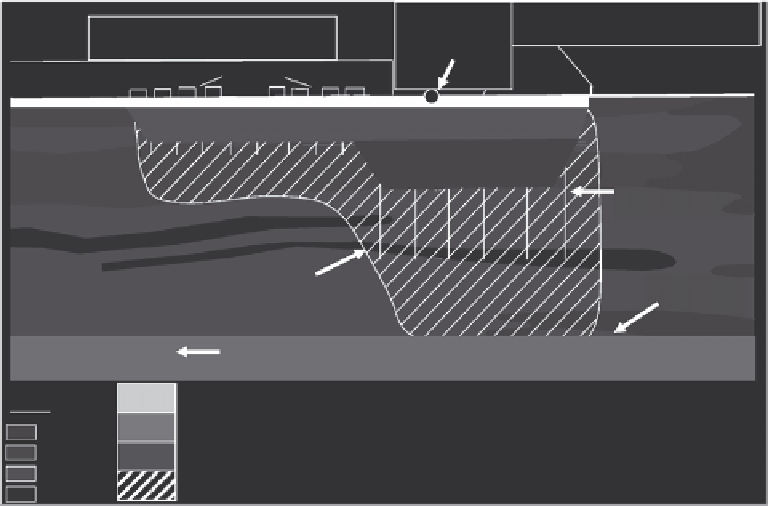Environmental Engineering Reference
In-Depth Information
Former
contaminant
source (sump)
Adjacent contaminated site
West
Case study 5 site
Former chrome plating tanks
East
Treatment
injection points
Area treated using
in situ injection of
a chemical reactant
Water table
Zone of saturation
Direction of groundwater flow
Legend
Silty sand
Silt/clay
Sand
Gravel
Excavated to 0.5 m
Excavated to 1.5 m
Excavated to 7.0 m
Treatment zone
FIGURE 14.21
Geologic cross section and areas selected for soil excavation and in situ treatment.
The selected technology for groundwater remediation was to pump and treat ground-
water within seven discrete zones using calcium polysulfide. The treated groundwater
was reinjected to create a circulation pattern within each of the seven treatment zones.
Each treatment zone was located along the longitudinal axis of the contaminant plume at
approximate intervals ranging from 500 to 1000 m. The spacing was contingent upon con-
taminant concentrations (i.e., higher concentrations earned a tighter spacing) and access
to the subsurface. Care was taken to ensure that the location of aboveground treatment
equipment was placed in areas that created minimal disturbance and maintained security.
This site exhibited a synergistic effect between a geologically vulnerable area and a
chemical with a high groundwater contaminant risk factor. When groundwater is affected,
costs soar; this is borne out by the more than $25 million it took to remediate this site's soil
and groundwater.
The lessons learned from this case study include
• Geologic maps are essential to all remediation efforts. In areas where there is high
geologic vulnerability and highly mobile contaminants, the synergistic effects
produced by their interaction can be better predicted by knowing the aquifer
structure and subsurface flow patterns.
• Application of effective urban investigative techniques such as collecting ground-
water samples using a cone penetrometer (CPT) method in easements and aquifer
profiling assists with the investigation and remedial efforts.
• Contamination occurring at sites where there is vulnerable geology and high-risk
contaminants is likely to exhibit synergistic effects, and be costly to remediate.

Search WWH ::

Custom Search